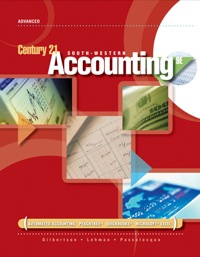




Required information Problem 5-1A Perpetual: Alternative cost flows LO P1 (The following information applies to the questions displayed below.) Warnerwoods Company uses a perpetual inventory system. It entered into the following purchases and sales transactions for March Units Sold at Retail Units Acquired at Cost 100 units @ $50.00 per unit 400 units @ $55.00 per unit Date Activities Mar. 1 Beginning inventory Mar. 5 Purchase Mar. 9 Sales Mar. 18 Purchase Mar. 25 Purchase Mar. 29 Sales Totals 420 units @ $85.00 per unit 120 units @ $60.00 per unit 200 units @ $62.00 per unit 160 units @ $95.00 per unit 580 units 820 units Problem 5-1A Part 3 3. Compute the cost assigned to ending inventory using (a) FIFO, (b) LIFO, (c) weighted average, and (d) specific identification. For specific identification, the March 9 sale consisted of 80 units from beginning inventory and 340 units from the March 5 purchase; the March 29 sale consisted of 40 units from the March 18 purchase and 120 units from the March 25 purchase. Answer is not complete. Complete this questions by entering your answers in the below tabs. Perpetual FIFO Perpetual LIFO Weighted Average Specific Id Compute the cost assigned to ending inventory using specific identification. For specific identification, the March 9 sale consisted of 80 units fr inventory and 340 units from the March 5 purchase; the March 29 sale consisted of 40 units from the March 18 purchase and 120 units from ---L--- 1 Perpetuai rinu Perneral LIFU SDPICIO 0 Required information n beginning inventory and 340 units from the March 5 purchase; the March 29 sale consisted of 40 units from the March 18 purchase and 120 units from the March 25 purchase. Specific Identification: Goods Purchased Inventory Balance Cost per # of units Cost of Goods Sold # of units Cost per Cost of Goods sold unit Sold Cost per Date # of units unit Inventory unit Balance $ 50.00 = $5,000.00 March 1 100 @ March 5 400 @ $ 55.00 100 @ 4001 @ $ 50.00 = $ 55.00 = $5,000.00 22,000.00 27,000.00 March 9 20 @ $50.00 = $1,000.00 420 @ $50.00 @ $55.00 $ 21,000.00 0.00 $ 21,000.00 60 @ $ 55.00 = $3,300.00 $4,300.00 March 18 120 @ $ 60.00 20 @ 60 @ 120 @ $ 50.00 = $ 55.00 = $ 60.00 = $1,000.00 3,300.00 7,200.00 $ 11,500.00 March 25 200 @ $ 62.00 20 @ 60 @ 120 @ 200 @ $ 50.00 = $ 55.00 = $ 60.00 = $ 62.00 = $1,000.00 3,300.00 7,200.00 12,400.00 $ 23,900.00 March 29 160 @ @ $ 8,000.00 0.00 $ 50.00 $ 55.00 $ 60.00 $ 62.00 20 @ 60 @ 80 @ 80 @ $50.00 = $ 55.00 = $ 60.00 = $ 62.00 = @ 0.00 @ 0.00 $1,000.00 3,300.00 4,800.00 4,960.00 $ 14,060.00 $ 14,060.00 $ 8,000.00 Totals $ 29,000.00 Compute the cost assigned to ending inventory using FIFO. Perpetual FIFO: Goods Purchased # of units unit Cost per Cost of Goods Sold # of units Cost per Cost of Goods sold unit Sold Date Inventory Balance # of units Cost per Inventory unit Balance 100 @ $ 50.00 = $5,000.00 March 1 March 5 400 @ $ 55.00 $ 50.00 = 100 @ 400 @ $ 55.00 $5,000.00 22,000.00 $ 27,000.00 March 9 420 @ $ 50.00 = o @ $ 50.00 o @ $ 55.00 $ 21,000.00 0.00 $ 21,000.00 80 @ $ 55.00 4,400.00 $4,400.00 March 18 120 @ $ 60.00 0 @ $ 50.00 $ 55.00 = 80 @ 120 @ $ 60.00 = 4,400.00 7,200.00 $ 11,600.00 March 25 200 @ $ 62.00 o @ 80 @ $ 50.00 $ 55.00 = $ 60.00 = $ 62.00 = 120 @ 2001 @ 4,400.00 7,200.00 12,400.00 $ 24,000.00 March 29 160 @ ol @ 160 @ = $ 50.00 $ 55.00 $ 60.00 $ 62.00 0 @ 401 @ $ 50.00 $ 55.00 $ 60.00 = $ 62.00 160 @ = 160 @ $ 8,000.00 8,800.00 9,600.00 9,920.00 $ 36,320.00 $ 57,320.00 = 2001 @ 2,400.00 12,400.00 $ 14,800.00 $ 14,800.00 Totals Complete this questions by entering your answers in the below tabs. Perpetual FIFO Perpetual LIFO Weighted Average Specific Id Compute the cost assigned to ending inventory using weighted average. (Round your average cost per unit to 2 decimal places.) Weighted Average Perpetual: Goods Purchased # of Date units unit March 1 Cost per Cost of Goods Sold # of units Cost per Cost of Goods sold unit Sold Inventory Balance Cost per Inventory # of units unit Balance 100 @ $ 50.00 $ 5,000.00 March 5 400 @ $ 55.00 100 @ 400 @ 500 @ $ 50.00 $ 55.00 = $ 5,000.00 22,000.00 $ 27,000.00 Average March 9 420 @ $ 85.00 = $ 35,700.00 80 @ $ 55.00= $ 4,400.00 March 18 120 @ $ 60.00 80 @ 120 @ 200 @ $ 55.00 = $ 60.00 = $ 62.00] = $ 4,400.00 7,200.00 $ 11,600.00 Average March 25 200 @ $ 62.00 200 @ 2001 @ 400 @ $ 62.00 = $ 62.00 = $ 12,400.00 12,400.00 $ 24,800.00 March 29 160 @ $ 95.00 = 401 @ $ 60.00] = $ 2,400.00 $ 15,200.00 $ 50,900.00 Totals











